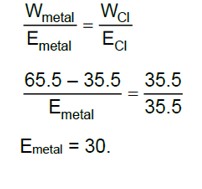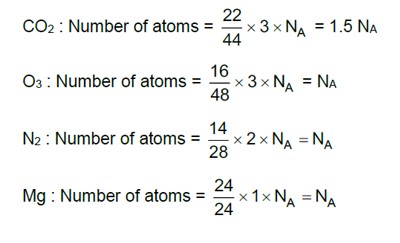1.21. The following data were obtained when dinitrogen and dioxygen react together to form compounds: (Beginner)
Mass of dinitrogen Mass of dioxygen
(i) 14 g 16 g
(ii) 14 g 32 g
(iii) 28 g 32 g
(iv) 28 g 80 g
(a)
Which law of chemical combination is obeyed by the above experimental data? Give its statement.
(b)
Fill in the blanks in the following conversions:
(i) 1 km = ...................... mm = ...................... pm
(ii) 1 mg = ...................... kg = ...................... ng
(iii)1 mL = ...................... L = ...................... dm3
1.21. The following data were obtained when dinitrogen and dioxygen react together to form compounds: (Beginner)
Mass of dinitrogen Mass of dioxygen
(i) 14 g 16 g
(ii) 14 g 32 g
(iii) 28 g 32 g
(iv) 28 g 80 g
(a) Which law of chemical combination is obeyed by the above experimental data? Give its statement.
(b) Fill in the blanks in the following conversions:
(i) 1 km = ...................... mm = ...................... pm
(ii) 1 mg = ...................... kg = ...................... ng
(iii)1 mL = ...................... L = ...................... dm3
-
1 Answer
-
1.21. (a) Fixing the mass of dinitrogen as 28 g, masses of dioxygen combined will be 32,64, 32 and 80 g in the given four oxides. Theseare in the ratio 1: 2: 1: 5 which is a simple whole number ratio. Hence, the given data obeys the law of multiple proportions.
(b)
(i) 1 km = 103 m and 1 m = 103 mm. So, 1 km = 103 x 103 mm = 106 mm
Now, 1 pm = 10-12 m. So, 1 km = 103 m x 1012 m = 1015 pm
Therefore, 1 km = 106 mm = 1015 pm
(ii) 1 mg = 10-3 g and 1 g = 10-3kg. So, 1 mg = 10-3 x 10-3 kg = 10-6 kg
Now, 1 mg = 10-3 g and 1 g =
Therefore, 1 mg = 10-6 kg = 106 ng
1L = 1000 mL.So 1 mL = 10-3 L.
Now, 1 mL = 1cm3 and 1dm = 10cm. So, 1 mL = 1
...more
Similar Questions for you
In the medical entrance test NEET, there can be 1 to 3 questions from this chapter. Some year, the Chemistry section of NEET has only one question from this chapter and in some other years, there can be 3 questions.
The following are the key concepts of this chapter: Compound, Elements, Rules, Law of conservation of mass, Addition and Subtraction, Atomic Mass, Law of multiple proportions, and Molecular Mass.
As the name suggests, the first chapter of the NCERT Class 11 Chemistry introduces various basic concepts of chemistry, such as the definition and importance of chemistry, atomic matter and molecular masses, the mole concept, laws of chemical combination, empirical, stoichiometry, and molecular formulas. It also includes the concepts of molarity and molality.
Taking an Exam? Selecting a College?
Get authentic answers from experts, students and alumni that you won't find anywhere else
Sign Up on ShikshaOn Shiksha, get access to
- 65k Colleges
- 1.2k Exams
- 679k Reviews
- 1800k Answers


